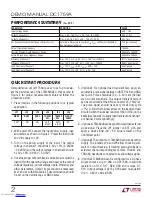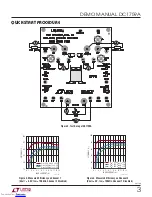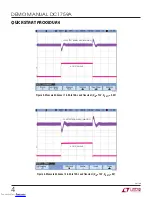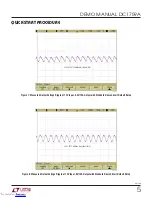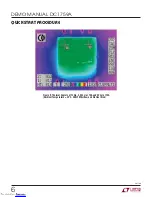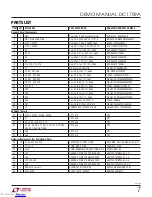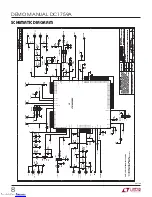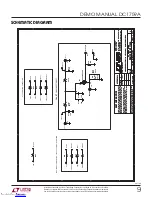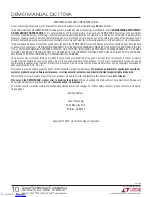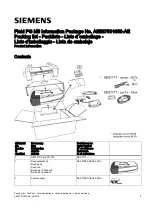
2
dc1759af
DEMO MANUAL DC1759A
QUICK START PROCEDURE
Demonstration circuit 1759A is easy to set up to evalu-
ate the performance of the LTM4620AEV. Please refer to
Figure 2 for proper measurement setup and follow the
procedure below:
1. Place jumpers in the following positions for a typical
application:
JP1
JP2
JP3
JP4
JP5
JP6
MODE
RUN1
RUN2
TRACK1
SEL.
TRACK2
SEL.
CLKOUT
PHASE
CCM
ON
ON
SOFT-
START
SOFT-
START
90°
2. With power off, connect the input power supply, load
and meters as shown in Figure 2. Preset the load to 0A
and V
IN
supply to 12V.
3. Turn on the power supply at the input. The output
voltage in channel 1 should be 3.3V ±1.5% (3.2505V
~ 3.3495V) and the output voltage in channel 2 should
be 5V ±1.5% (4.925V ~ 5.075V).
4. Once the proper output voltage is established, adjust the
load within the operating range and observe the output
voltage regulation, output voltage ripple, efficiency and
other parameters. Output ripple should be measured
at J1 and J2 with BNC cables. 50Ω termination should
be set on the oscilloscope or BNC cables.
5. (Optional) For optional load transient test, apply an
adjustable pulse signal between IOSTEP CLK and GND
test point. Pulse amplitude (3V ~ 3.5V) sets the load
step current amplitude. The output transient current
can be monitored at the BNC connector J3 (15mV/A).
The pulse signal should have very small duty cycle
(<1%) to limit the thermal stress on the transient load
circuit. Switch the jumper resistors R34 or R35 (on the
backside of boards) to apply load transient on channel 1
or channel 2 correspondingly.
6. (Optional) LTM4620A can be synchronized to an external
clock signal. Place the JP1 jumper on EXT_CLK and
apply a clock signal (0V ~ 5V, square wave) on the
CLKIN test point.
7. (Optional) The outputs of LTM4620A can track another
supply. The jumpers JP4 and JP5 allow choosing soft-
start or output tracking. If tracking external voltage is
selected, the corresponding test points, TRACK1 and
TRACK2, need to be connected to a valid voltage signal.
8. (Optional) LTM4620A can be configured for a 2-phase
single output at up to 26A on DC1759A. Install 0Ω
resistors on R14, R17, R28, R39 and remove R7,
R19. Output voltage is set by R25 based on equation
V
OUT
= 0.6V(1 + 60.4k/R25).
PERFORMANCE SUMMARY
PARAMETER
CONDITION
VALUE
Input Voltage Range
5.5V ~ 16V
Output Voltage V
OUT1
V
IN
= 5.5V ~ 16V, I
OUT1
= 0A ~ 13A, JP1: CCM
3.3V ±1.5%
Output Voltage V
OUT2
V
IN
= 5.5V ~16V, I
OUT2
= 0A ~ 13A, JP1: CCM
5V ±1.5%
Per-Channel Maximum Continuous Output Current
Derating is Necessary for Certain V
IN
, V
OUT
and Thermal Conditions,
See Data Sheet for Detail.
13A (per-Channel)
Default Operating Frequency
750kHz
Resistor Programmable Frequency Range
250kHz to 780kHz
External Clock Sync. Frequency Range
400kHz to 780kHz
Efficiency of Channel 1
V
IN
= 12V, V
OUT1
= 3.3V, I
OUT1
= 13A, f
SW
= 750kHz
91.7% See Figure 3
Efficiency of Channel 2
V
IN
= 12V, V
OUT2
= 5V, I
OUT2
= 13A, f
SW
= 750kHz
93.8% See Figure 4
Load Transient of Channel 1
V
IN
= 12V, V
OUT1
= 3.3V, I
SETP
= 6.5A ~ 13A
See Figure 5
Load Transient of Channel 2
V
IN
= 12V, V
OUT2
= 5V, I
SETP
= 6.5A ~ 13A
See Figure 6
(T
A
= 25°C)
Downloaded from
Downloaded from


